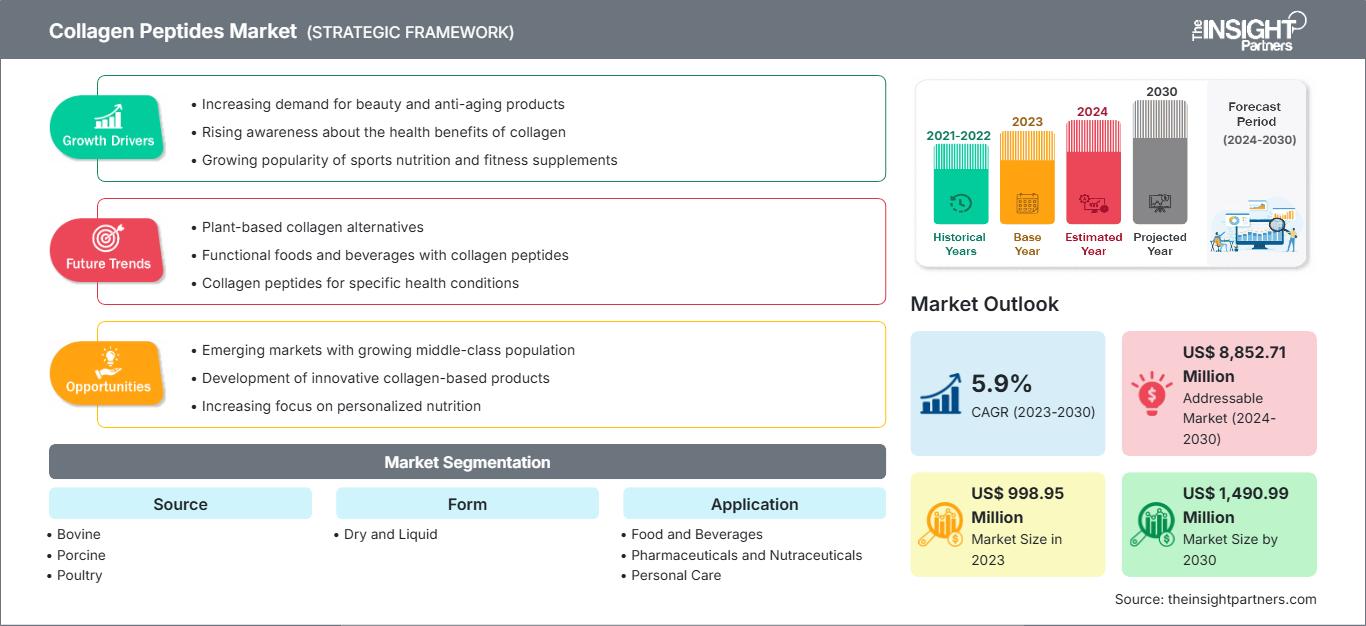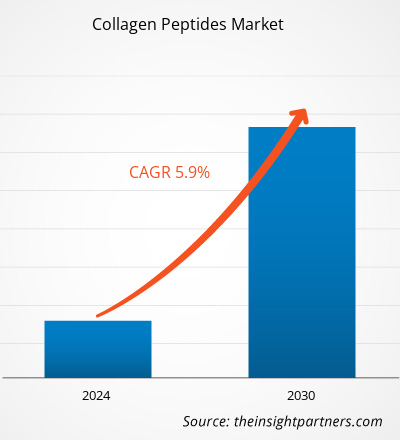[Rapport de recherche] Le marché des peptides de collagène était évalué à 998,95 millions de dollars américains en 2023 et devrait atteindre 1 490,99 millions de dollars américains d'ici 2030 ; il devrait enregistrer un TCAC de 5,9 % de 2023 à 2030.
Le marché mondial des peptides de collagène est très concurrentiel, avec un grand nombre de fabricants locaux, régionaux et mondiaux qui se font concurrence sur la qualité et l'innovation de leurs produits. Quelques fabricants de peptides de collagène ont obtenu les certifications casher et halal, renforçant ainsi leur position concurrentielle sur le marché mondial. Par exemple, Rousselot, l'un des principaux fabricants de collagène, possède des unités de production certifiées halal et casher. De plus, l'entreprise a également obtenu les certifications IFS, ISO 9001, GMP+ et FCA, renforçant ainsi sa position sur le marché. Les fabricants investissent également dans l'innovation et le développement de nouveaux produits pour répondre à l'évolution des préférences des clients. Par exemple, Evonik Industries Inc. a récemment lancé du collagène végétalien utilisant un procédé de fermentation. Cette initiative devrait offrir des opportunités lucratives aux fabricants sur le marché mondial des peptides de collagène.
En 2022, l'Amérique du Nord détenait la plus grande part du marché mondial des peptides de collagène, et l'Asie-Pacifique devrait enregistrer le TCAC le plus élevé au cours de la période de prévision. Les peptides de collagène sont utilisés dans divers compléments alimentaires, tels que les poudres, les gélules, les comprimés et les bonbons gélifiés. La forte demande de nutraceutiques dans la région stimule principalement les ventes de peptides de collagène. Par conséquent, l'industrie des nutricosmétiques intègre de plus en plus de peptides de collagène pour répondre aux besoins des consommateurs. De plus, les peptides de collagène sont efficaces contre l'atrophie osseuse, la perte de densité osseuse et la stabilité osseuse. Par conséquent, leur large champ d'application stimule la demande de peptides de collagène dans la région.
Personnalisez ce rapport en fonction de vos besoins
Vous bénéficierez d’une personnalisation sur n’importe quel rapport - gratuitement - y compris des parties de ce rapport, ou une analyse au niveau du pays, un pack de données Excel, ainsi que de profiter d’offres exceptionnelles et de réductions pour les start-ups et les universités
Marché des peptides de collagène: Perspectives stratégiques

-
Obtenez les principales tendances clés du marché de ce rapport.Cet échantillon GRATUIT comprendra une analyse de données, allant des tendances du marché aux estimations et prévisions.
Impact de la pandémie de COVID-19 sur le marché des peptides de collagène
La consommation croissante d'aliments et de boissons fonctionnels, de compléments alimentaires et la forte demande de produits riches en protéines sont les principaux facteurs qui ont stimulé la croissance du marché des peptides de collagène avant le début de la pandémie de COVID-19. Cependant, ces industries ont été confrontées à des défis sans précédent après l'épidémie de 2020.
En 2021, plusieurs économies ont repris leurs activités, les gouvernements de plusieurs pays ayant annoncé un assouplissement des restrictions précédemment imposées, ce qui a stimulé le marché mondial. De plus, les fabricants ont été autorisés à fonctionner à pleine capacité, ce qui les a aidés à surmonter l'écart entre l'offre et la demande et d'autres répercussions. Alors que de nombreux citoyens de nombreux pays étaient entièrement vaccinés en 2021, les fabricants de peptides de collagène se sont concentrés sur l'augmentation de leur production pour relancer leurs activités.
Aperçu du marché
La forte demande de peptides de collagène d'origine marine stimulera la croissance du marché des peptides de collagène
Les organismes marins tels que les poissons, les méduses, les éponges et autres invertébrés abritent une source importante de peptides de collagène. Ils sont très avantageux par rapport aux autres sources, car ils sont métaboliquement compatibles, n'ont pas de contraintes religieuses et sont exempts d'agents pathogènes animaux. De plus, les peptides de collagène d'origine marine peuvent être utilisés comme biomatériaux grâce à leur solubilité dans l'eau et leur compatibilité métabolique. Ainsi, la demande en peptides de collagène d'origine marine augmente avec leur utilisation croissante pour diverses applications industrielles.
De plus, les peptides de collagène d'origine marine ne favorisent pas les maladies transmissibles. Les animaux terrestres sont porteurs de nombreuses maladies transmissibles, ce qui les rend moins propices à une utilisation industrielle. Par exemple, le bétail, bien qu'important pourvoyeur de collagène, présente des risques d'ESB et d'EST. Ces facteurs font des peptides de collagène d'origine marine une alternative beaucoup plus simple, plus sûre et plus prometteuse. Face à la demande croissante, les fabricants lancent différents produits. Par exemple, en janvier 2021, Darling Ingredients a lancé Peptan, un peptide de collagène marin sous sa marque Rousselot. Ce produit permet à l'entreprise de pénétrer le marché des compléments alimentaires. Ainsi, la demande croissante de collagène d'origine marine devrait ouvrir de nouvelles perspectives sur le marché des peptides de collagène au cours de la période de prévision.
Informations basées sur les sources
Selon les sources, le marché des peptides de collagène est divisé en bovins, porcins, avicoles, marins et autres. Le segment bovin détenait la plus grande part de marché en 2022, tandis que le segment marin a enregistré la croissance la plus rapide au cours de la période de prévision. Les peptides de collagène marins sont principalement obtenus à partir de différentes variétés de poissons, de méduses et d'éponges. Ainsi, la demande de peptides de collagène d'origine marine augmente en tant que substitut aux peptides bovins et porcins, ce qui devrait avoir un impact sur la croissance du marché des peptides de collagène.
Aperçu des applications
En fonction des applications, le marché des peptides de collagène est segmenté en aliments et boissons, produits pharmaceutiques et nutraceutiques, soins personnels, etc. Le segment des aliments et boissons devrait enregistrer le TCAC le plus élevé au cours de la période de prévision. Dans les produits laitiers, il est utilisé comme agent de texturation et de stabilisation. Les hydrolysats de collagène peuvent fixer des ions calcium, améliorant ainsi leur biodisponibilité. Ainsi, les peptides de collagène peuvent être utilisés dans les ingrédients alimentaires fonctionnels pour gérer les carences en minéraux.
Les peptides de collagène peuvent être bénéfiques pour les aliments devant être conservés à des températures froides ou glaciales, car ils agissent comme anticoagulants et contribuent à réduire les dommages cellulaires et tissulaires. Ils contribuent à améliorer et à maintenir les propriétés sensorielles, physiques et chimiques du produit. Ainsi, grâce à ces propriétés, les peptides de collagène sont utilisés dans la préparation de différents produits tels que la viande, les boissons et les soupes.
Les principaux acteurs du marché des peptides de collagène sont GELITA AG, Rousselot BV, Titan Biotech Ltd, Tessenderlo Group NV, Ewald-Gelatine GmbH, BioCell Technology LLC, Lapi Gelatine SpA, Weishardt Holding SA, Nippi Collagen NA Inc et Nitta Gelatin India Ltd. Ces entreprises se concentrent sur le lancement de nouveaux produits et l'expansion géographique afin de répondre à la demande croissante des consommateurs à l'échelle mondiale et d'élargir leur gamme de produits dans des portefeuilles spécialisés. Ils ont une présence mondiale étendue, ce qui leur permet de servir un large éventail de clients et d'augmenter par la suite leur part de marché.
Marché des peptides de collagèneLes tendances régionales et les facteurs influençant le marché des peptides de collagène tout au long de la période de prévision ont été analysés en détail par les analystes de The Insight Partners. Cette section aborde également les segments et la géographie du marché des peptides de collagène en Amérique du Nord, en Europe, en Asie-Pacifique, au Moyen-Orient et en Afrique, ainsi qu'en Amérique du Sud et en Amérique centrale.Portée du rapport sur le marché des peptides de collagène| Attribut de rapport | Détails |
|---|---|
| Taille du marché en 2023 | US$ 998.95 Million |
| Taille du marché par 2030 | US$ 1,490.99 Million |
| TCAC mondial (2023 - 2030) | 5.9% |
| Données historiques | 2021-2022 |
| Période de prévision | 2024-2030 |
| Segments couverts |
By Source
|
| Régions et pays couverts |
Amérique du Nord
|
| Leaders du marché et profils d'entreprises clés |
|
Densité des acteurs du marché des peptides de collagène : comprendre son impact sur la dynamique des entreprises
Le marché des peptides de collagène connaît une croissance rapide, portée par une demande croissante des utilisateurs finaux, due à des facteurs tels que l'évolution des préférences des consommateurs, les avancées technologiques et une meilleure connaissance des avantages du produit. Face à cette demande croissante, les entreprises élargissent leur offre, innovent pour répondre aux besoins des consommateurs et capitalisent sur les nouvelles tendances, ce qui alimente la croissance du marché.
- Obtenez le Marché des peptides de collagène Aperçu des principaux acteurs clés
Points forts du rapport
- Tendances progressives du secteur sur le marché des peptides de collagène pour aider les entreprises à développer des stratégies efficaces à long terme
- Stratégies de croissance adoptées par les acteurs du marché dans les pays développés et en développement
- Analyse quantitative du marché de 2022 à 2030
- Estimation de la demande mondiale de peptides de collagène
- Analyse des cinq forces de Porter pour illustrer l'efficacité des acheteurs et des fournisseurs sur le marché des peptides de collagène
- Évolutions récentes pour comprendre le scénario concurrentiel du marché
- Tendances et perspectives du marché, moteurs et freins de croissance sur le marché des peptides de collagène
- Aide à la prise de décision en mettant en évidence les stratégies de marché qui sous-tendent l'intérêt commercial
- Taille du marché des peptides de collagène à différents niveaux
- Aperçu détaillé de l'industrie des peptides de collagène dynamique
- Taille du marché des peptides de collagène dans diverses régions avec des opportunités de croissance prometteuses
- Analyse historique (2 ans), année de base, prévision (7 ans) avec TCAC
- Analyse PEST et SWOT
- Taille du marché Valeur / Volume - Mondial, Régional, Pays
- Industrie et paysage concurrentiel
- Ensemble de données Excel
Rapports récents
Témoignages
Raison d'acheter
- Prise de décision éclairée
- Compréhension de la dynamique du marché
- Analyse concurrentielle
- Connaissances clients
- Prévisions de marché
- Atténuation des risques
- Planification stratégique
- Justification des investissements
- Identification des marchés émergents
- Amélioration des stratégies marketing
- Amélioration de l'efficacité opérationnelle
- Alignement sur les tendances réglementaires






















 Obtenez un échantillon gratuit pour - Marché des peptides de collagène
Obtenez un échantillon gratuit pour - Marché des peptides de collagène